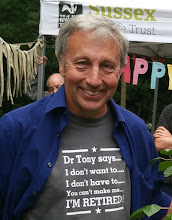
Scientific certainty
There is a high degree of certainty in the scientific community that climate change is happening. The nature, scale and even direction of climate change is, however, probably unpredictable at a Sussex scale. It is also likely that there will be increasing variability in local weather with possible large swings in conditions and less certainty about seasonal weather patterns.
Nevertheless, uncertainty about how climate change will unfold, or what the response of plants, animals and their habitats to climate change will be, must not prevent us from taking action.
Nevertheless, uncertainty about how climate change will unfold, or what the response of plants, animals and their habitats to climate change will be, must not prevent us from taking action.
A strategy for wildlife conservation
A strategy is needed that presents the best course of action to conserve nature against an unknown and unpredictable future. This means that we need to develop an adaptable environment that is resilient to change, whatever that change might be.
The best chance for wildlife, and therefore for us will be to:
1 – Look after our existing wildlife and wild places.
Future wildlife can only adapt and evolve from the plants and animals that survive today so the importance of conserving current high quality places cannot be overemphasised.
2 – Reduce damage to nature from sources other than climate change.
Nature will have the best chance if we stop pressurising it in other ways.
3 – Increase the variety of our landscape at all scales
A strategy is needed that presents the best course of action to conserve nature against an unknown and unpredictable future. This means that we need to develop an adaptable environment that is resilient to change, whatever that change might be.
The best chance for wildlife, and therefore for us will be to:
1 – Look after our existing wildlife and wild places.
Future wildlife can only adapt and evolve from the plants and animals that survive today so the importance of conserving current high quality places cannot be overemphasised.
2 – Reduce damage to nature from sources other than climate change.
Nature will have the best chance if we stop pressurising it in other ways.
3 – Increase the variety of our landscape at all scales
In this way so plants and animals always have somewhere to move to in their immediate area as conditions change.
4 – Build ecological networks throughout the landscape at all scales
Maintaining a diversity of habitats, increasing their area and the way they link up and allowing natural processes to shape the ecology and structure of whole landscapes will create the best chance for biodiversity.
The elements above make a good nature conservation strategy even if there was no climate change or if it was not caused by human activity. Building an adaptable, resilient environment is a good approach independently of climate change.
Providing the best chance for wildlife, as well as being a worth while objective in its own right, will also provide the best chance of maintaining a high quality environment that continues to provide the environmental services (such as flood amelioration, climate regulation, nutrient cycling and water purification) on which we all depend. This is not just about conserving the environment for nature, it is also about conserving the environment for people too.
An important element of a strategy for nature in a changing climate is the development of an ecological network for Sussex. This concept will be presented in “A Living Landscape for Sussex”, due to be published in early 2008.
However, and this point is vitally important, even the most effective biodiversity strategy will be overwhelmed if we do not take other action to address the causes of climate change: our continually growing emissions of greenhouse gases.
4 – Build ecological networks throughout the landscape at all scales
Maintaining a diversity of habitats, increasing their area and the way they link up and allowing natural processes to shape the ecology and structure of whole landscapes will create the best chance for biodiversity.
The elements above make a good nature conservation strategy even if there was no climate change or if it was not caused by human activity. Building an adaptable, resilient environment is a good approach independently of climate change.
Providing the best chance for wildlife, as well as being a worth while objective in its own right, will also provide the best chance of maintaining a high quality environment that continues to provide the environmental services (such as flood amelioration, climate regulation, nutrient cycling and water purification) on which we all depend. This is not just about conserving the environment for nature, it is also about conserving the environment for people too.
An important element of a strategy for nature in a changing climate is the development of an ecological network for Sussex. This concept will be presented in “A Living Landscape for Sussex”, due to be published in early 2008.
However, and this point is vitally important, even the most effective biodiversity strategy will be overwhelmed if we do not take other action to address the causes of climate change: our continually growing emissions of greenhouse gases.

2 comments:
I am very interested to hear your thoughts and the work happening for Sussex. I chair a group called the Hampshire Local Government Landscape Group its made up of landscape architects from the local authorities within Hampshire, the Isle of Wight and includes the county council. The group is looking to meet and discuss how landscape architects can facilitate the landscapes adaptation to climate change. Would you be interested in being involved in such a meeting?
Making money on the internet is easy in the hush-hush world of [URL=http://www.www.blackhatmoneymaker.com]blackhat traffic[/URL], You are far from alone if you don't know what blackhat is. Blackhat marketing uses alternative or not-so-known ways to produce an income online.
Post a Comment